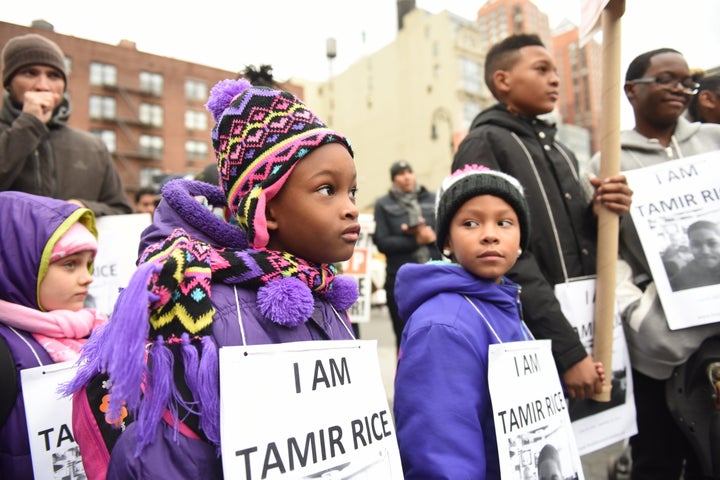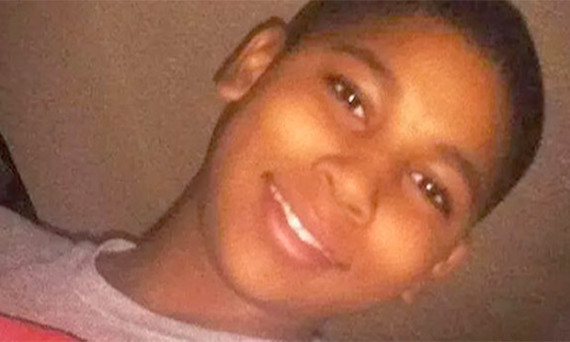Although a grand jury declined to indict the two Cleveland police officers involved in the shooting of 12-year-old Tamir Rice, Cuyahoga County Prosecutor Timothy McGinty wasn’t exactly acting like a someone who had suffered a major legal failure.
At a press conference on Monday, McGinty made no secret of the fact that he agreed with the decision, admitting that he had recommended to the grand jury that it not indict officers Timothy Loehmann and Frank Garmback.
The prosecutor had already attempted to convince the grand jury not to indict the men, commissioning expert reports that called their guilt into question and then leaking those reports to the media. As The Huffington Post’s Cristian Farias wrote, McGinty “turned the grand jury in the Tamir Rice case into his plaything.”
But on Monday, he didn't merely suggest that the police officers' use of force against Rice was justified. He selectively used information to excuse and defend their actions, and implicitly blamed the unarmed African-American boy who was killed -- something that is all too common in police killings.
Here are some of McGinty’s most questionable claims and observations:
Timothy Loehmann was a ‘reasonable’ police officer.
McGinty characterized Timothy Loehmann -- who shot Rice within seconds of arriving on the scene -- as a “reasonable” police officer. The grand jury also declined to indict Frank Garmback, who drove Loehmann in the police cruiser.
“The Supreme Court instructs to judge an officer by what he or she knew at the moment, not by what was learned later,” McGinty said. “We are instructed to ask what a reasonable police officer, with the knowledge he had, would do in this particular situation.”
But McGinty failed to explain that Loehmann's perception of what was "reasonable" may have been questionable.
After five months on the job, Loehmann quit the police force of the Cleveland suburb of Independence, Ohio, in December 2012, days after a deputy police chief recommended his dismissal. The deputy police chief based his recommendation on a firearms instructor’s report, obtained by NBC News, that Loehmann was experiencing an “emotional meltdown” that made his facility with a handgun “dismal.”
“They put a police officer in this situation who had a history of mental health problems,” said Michael Benza, a criminal law professor at Case Western Reserve University in Cleveland. “It may not have been ‘reasonable’ for him to shoot given his mental issues.”
Tamir Rice was big and scary.
McGinty suggested that 12-year-old Rice was threatening, though he conceded that the boy may have meant to explain that his gun was fake just before he was killed. According to the prosecutor, Rice looked bigger than most children his age and had already been warned that his gun might frighten people.
“If we put ourselves in the victim’s shoes, as prosecutors and detectives try to do, it is likely that Tamir, whose size made him look much older and who had been warned that his pellet gun might get him into trouble that day, either intended to hand it over to the officers or show them it wasn’t a real gun,” McGinty said.
While Rice’s appearance and the possibility that someone had warned him not to carry a toy gun may have been enough for a grand jury to determine that the officers' actions were justified, this does not mean that shooting him was unavoidable.
Steve Martin, an expert on the use of force in corrections settings, called the facts McGinty mentioned “kind of tangential.”
“If you come upon a situation where there is risk of harm, the question is how imminent is the threat,” Martin said. “That controls whether you can take time and distance to assess -- time to put distance between yourself and the subject" to assess whether the threat requires immediate action.
Driving up so close to Rice was likely a “poor tactical decision” by Garmback, the officer at the wheel, according to a former senior police official in another city who requested anonymity in order to comment freely, given the sensitivity of the case. The official currently helps a city government manage claims of excessive force or other wrongdoing by police officers.
“That was a tactical decision that required the man to make a much more rapid decision,” he said. “It looks like they could have stopped 100 or 200 yards away and taken cover.”
Still, McGinty and the grand jury evaluating the case believed the cops had a “reasonable belief” that Rice posed an immediate danger, according to the prosecutor.
“It looks like they could have stopped 100 or 200 yards away and taken cover.”
- Former senior police official
That was likely all officers needed to avoid indictment, since the legal threshold for indicting officers for use of force in the line of duty is incredibly high and a unique grand jury process was already tilted in the cops’ favor.
By taking the time to mention Rice’s size and possibly unwise decision to carry a toy gun, McGinty both implied that Rice had it coming and reinforced a common perception that black boys seem older and more menacing.
Psychologists have found that female U.S. college students who were shown photos of boys of different races viewed African-American boys ages 10 and older as less innocent than their white peers. The young women also estimated that the boys were 4.5 years older on average than they actually were.

Officers were on edge because other cops were killed nearby.
McGinty also mentioned that the fear of death might have weighed more heavily on Loehmann and Garmback since police officers had been killed previously near the park where Loehmann shot Rice.
“The police were prepared to face a possible active shooter in a neighborhood with a history of violence,” McGinty said. “There are, in fact, memorials to slain Cleveland police officers in that very park, a short distance away, and both had been shot to death in the line of duty.”
It's not exactly clear why McGinty would note this, but he appears to be suggesting that the two previous shootings -- dating back to 2006 and 1996, respectively -- were fresh in Loehmann and Garmback's minds when they approached Rice.
“I am not sure where in Cleveland is not a high-crime area.”
- Michael Benza, Case Western Reserve University School of Law
Regardless, these details should have little bearing on whether Loehmann's decision to shoot Rice was justified, and whether Garmback miscalculated by pulling up so close to the boy.
Police officers routinely work in neighborhoods where violence is common. The fact that two officers had been killed many years earlier near the park where they encountered Rice should not have affected how they viewed the 12-year-old.
“One of the contradictions that has come out in this case is that the prosecutors will say, ‘We are only evaluating conduct at the moment of the shooting,’ and then immediately step back and talk about the toy gun and everything else,” said Benza, who has worked a public defense attorney in Ohio.
“I am not sure where in Cleveland is not a high-crime area,” he added. “Those are the places where police are active.”

Rice could have been McGinty’s son or grandson.
McGinty did his best to emphasize that the officers’ lack of criminal culpability before the law did not diminish the tragedy of Rice’s death. He even said it touched him personally.
“The outcome will not cheer anyone, nor should it,” McGinty said. “Every time I think about this case, I cannot help but feel that the victim could have been my own son or grandson.”
There is just one problem with that: McGinty is white and, as far as we know, does not have any black children or grandchildren.
“It would have been a completely different interaction if it had been his son or grandson, and that is because of race,” Benza said. “We have allowed race to influence whether an officer believes he or she is threatened. One of the factors officers will use in assessing a threat is the race of the person they are dealing with.”
McGinty himself inadvertently underscored the way race can creep into officers’ decision-making when he suggested that the crime rate in the neighborhood where Rice was killed had made it more reasonable for the cops to fear him.
“It would have been a completely different interaction if it had been his son or grandson, and that is because of race.”
- Michael Benza, Case Western Reserve University School of Law
Benza argues that in Ohio, where residents with a permit are allowed to carry guns in the open, it's especially apparent that gun owners are treated differently, depending on their race. People sometimes call the police when they see white people walking down the street with assault-style rifles, yet they are rarely treated as active shooters the way Rice was.
“When [police] go into a neighborhood where there is a perception of danger and they see a big black guy that matches the description of a guy with a gun, they are going to act very differently than if they see a white guy with a gun in the suburbs,” Benza concluded.
Also on HuffPost:


